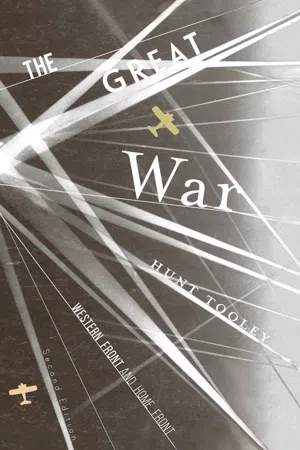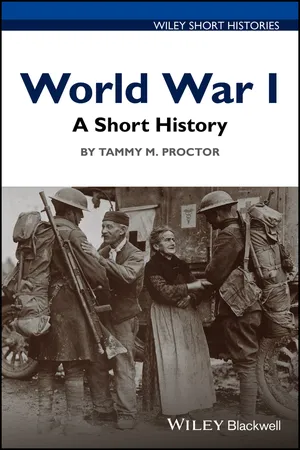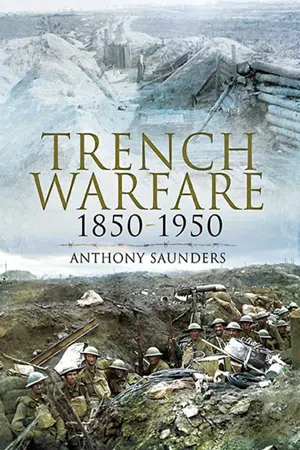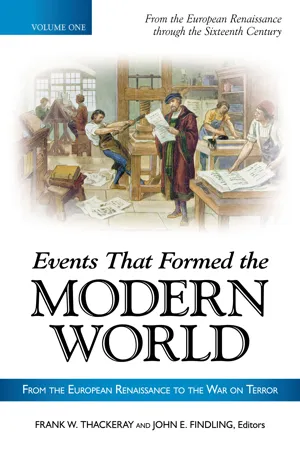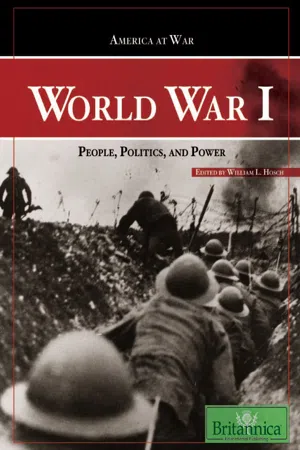History
Stalemate WW1
Stalemate in WW1 refers to the prolonged period of trench warfare on the Western Front, where neither side was able to make significant gains. This was due to the development of new technologies such as machine guns and artillery, which made it difficult for troops to advance. The stalemate lasted for several years until the introduction of new tactics and weapons broke the deadlock.
Written by Perlego with AI-assistance
Related key terms
Related key terms
1 of 4
Related key terms
1 of 3
7 Key excerpts on "Stalemate WW1"
- eBook - ePub
The Great War
Western Front and Home Front
- Hunt Tooley(Author)
- 2015(Publication Date)
- Bloomsbury Academic(Publisher)
3 Stalemate and Mobilization, 1915/1916The metaphor of “stalemate” is apt to mislead us as much as enlighten us if we apply it too literally to the Western Front. It was a potent concept of the era, which influenced the actions of participants, decision-makers, and bystanders, and in large measure, the history of the Western Front has been envisioned in terms of stalemate.1 Since the 1980s, on the other hand, historians have begun to emphasize change and development rather than stasis. Yet even in light of new material emphasizing the extent to which the battle front itself changed during the four years of war, the idea of stalemate is still a useful analytical tool for thinking about the course of the war, both on the battle front and on the home front. It is necessary first, of course, to comprehend the nature of this stalemate, and we make a good start by understanding that individuals and armies in 1915 were not inactive, hamstrung, or otherwise unable to introduce new ideas and adopt clear courses of action. Indeed, in some ways, the military behaviors of the Western Front powers in the period from November 1914 to the crucial year 1916 represented sometimes frantic, sometimes fatalistic, plans in reaction to or even in fear of stalemate itself.The generation of stalemateAlthough the Western Front can seem a monotonous parade of failed and self-destructive offensives, some of the individuals most engaged in the actual conduct of the war – not necessarily the commanding generals – were also engaged in the design of new methods and techniques of warfare at a rate far exceeding various phases of earlier military change dubbed “revolutionary” by historians. A host of special weapons and tactics emerged during this period, from new artillery techniques to the use of gas and flamethrowers to the astounding development of military aviation almost from scratch. Nearly all of these innovations related to the problems of fighting a war of entrenched positions, without flanks, across a 400-mile front – in a word, a war of stalemate. - eBook - ePub
World War I
A Short History
- Tammy M. Proctor(Author)
- 2017(Publication Date)
- Wiley-Blackwell(Publisher)
For anyone taking a survey of the battlefronts in early 1915, the war looked static (see Map 3.1). Most of the offensives had stalled, winter had set in, and serious trench networks had emerged on both the Eastern and Western Fronts. Military and civil leaders alike began to consider the problem of “stalemate,” which was a term borrowed from the game of chess. In its original meaning, a player cannot move any pieces without going into check. This seemed a perfect description of the situation of the war by early 1915—no one could move without catastrophic losses, and normal strategies appeared illogical. Not only was stalemate a conundrum in terms of accomplishing any strategic goals, but it cost a lot of money to keep millions of soldiers in the field waiting for something to happen. Governments who were draining their treasuries began borrowing and taxing to finance the war. Action was needed, but the question of what action seemed an open one. Generals knew that outflanking maneuvers were impossible in most of the entrenched battlefronts of the war, so they faced either frontal assaults with great casualties or some other creative approach. Planners had several ideas for how to address the stalemate, and each in turn made an appearance in 1915. Every plan depended on the idea of a big breakthrough that would knock the enemy out of contention, and this concept remained a constant throughout the rest of the war. This led to experimentation in terms of military tactics and technologies.1915 and the Problem of Stalemate
A popular notion about how to deal with stalemate was to develop technology that would enable the big breakthrough that would crush enemy forces. Armies experimented with handheld weapons such as flamethrowers and brass knuckles, but they also sought to create defensive equipment such as body armor that would provide an advantage. When battlefield advances did not provide a breakthrough capacity, planners turned to a broader field of vision in their search for new technologies. One such advance was the widening of the air war to include aerial bombing of civilian and military targets by zeppelins and planes in order to break morale and destroy resources. Another was an expansion of unrestricted submarine warfare by the Germans, especially in the Atlantic, which culminated in the sinking of the passenger liner, RMS Lusitania - eBook - ePub
The Illustrated History of World War I
The Battles, Personalities, Events and Key Weapons From All Fronts In The First World War 1914-18
- Andrew Wiest(Author)
- 0(Publication Date)
- Amber Books Ltd(Publisher)
HAPTER 4Stalemate in the Trenches
THE WORLD OF THE TRENCHES WAS ONE OF SQUALOR AND HARDSHIP AS DEPICTED BY THESE BRITISH SOLDIERS RESTING AMIDST THE LITTER OF WAR . AT ANY MOMENT THE TRENCH COULD BE SHELLED BY THE GERMAN GUNS , SENDING THE SOLDIERS SCURRYING TO THEIR DUG -OUTS .At the centre of the strategic debate was the advent of an unexpected new, attritional style of modern warfare. World War I had settled down into something that resembled a gigantic siege, a siege that many felt threatened to destroy the old world.STRATEGIC DEBATE
A fter failing to achieve victory at First Ypres, Falkenhayn had to attempt to come to terms with a two-front war. After much study, he concluded that the war in the west was a stalemate, and that in the east the Russians could give ground for an almost indeterminate length of time, denying German forces a meaningful victory. The German commander realised then that the war had degenerated into a war of attrition. Hindenburg and Ludendorff, the heroes of Tannenberg, did not agree. They argued that decisive victory beckoned in the east, if only Falkenhayn would transfer to them much-needed reinforcements. In the end, Falkenhayn agreed. The German offensive efforts of 1915 — with one notable exception — would be directed against Russia.GENERAL ERICH VON FALKENHAYN , THE ARCHITECT OF GERMAN STRATEGY IN 1915, WHO SAW THE WAR AS ONE OF ATTRITION .The Allies, too, had similar strategic problems. The French, led by Joffre, were quite certain that any Allied attack had to be made on the Western Front in order to expel the German Army from France. The British were not so certain. Several key British policy-makers, including Winston Churchill, the First Lord of the Admiralty, and David Lloyd George, sought to circumvent the stalemated Western Front and attack elsewhere in Europe against less stalwart enemies. Thus dawned the ‘Easterner-Westerner’ debate that would haunt Allied planning for the rest of the war. Suggestions for an eastern alternative included landing British troops on the North German Plain as a direct threat to Berlin, landing troops in Greece to aid the Serbs, and landing troops at Gallipoli in an effort to defeat the newest German ally: Turkey. Most of the British military, including French and Haig, were vehemently opposed to any eastern strategy. They contended that Germany was the main enemy, and that striking Turkey would do little to help defeat the Germans. Though the debate in Britain raged on, in 1915 France remained the senior alliance partner. As the French were bearing the main burden of the war, they retained a firm control over Allied planning. As a result, the main Allied efforts of 1915 came on the Western Front. The only victory for the Easterners was in a seemingly rather minor naval assault on the Dardanelles. - eBook - ePub
- Anthony Saunders(Author)
- 2010(Publication Date)
- Pen & Sword Military(Publisher)
Trench warfare is usually described as military operations between two entrenched armies. It is a form of stalemate in which neither side can breach or outflank the defences of the other so that breakthrough cannot be achieved, irrespective of the size or type of operation carried out to achieve that aim. In other words, it is mutual siege. The manner in which the fighting is conducted, and the nature of the weapons used and their numbers, all factor into the equation since these contribute to the stalemate and its intractability. If this were not the case, ‘trench warfare’ would have occurred in the eighteenth century. Clearly, there is a complex relationship between the various factors which, in the right balance, produce stalemate and, hence, trench warfare. In other words, there has to be a fluid balance between the opposing armies to prevent breakthrough in order for trench warfare to occur.While artillery was a major factor in the development of stalemate during the First World War, the development of trench warfare in the American Civil War was attributable to the greater firepower of small arms. In both instances, however, there was a conflict between firepower and tactics which resulted in the inability of tactical theories to overcome the practicalities of firepower. The relative proportions of such weapons and the amount of ammunition available to the guns all contributed to the formation and continuation of the stalemate. Thus, forward movement by the infantry could not be achieved nor the defences broken because defensive firepower broke up attacks, while the firepower of the attackers was insufficient to break the defenders. There was a dynamic relationship between guns, trenches and tactics. It is the relationship between these, more than anything else, which determines whether stalemate and trench warfare will occur. While the invention of barbed wire in 1873 was not originally devised for military use, its potential was quickly appreciated by governments and it added a new dimension to the battlefield. It was to become a defining feature of trench warfare.With the establishment of entrenched positions from which opposing armies faced each other came a defining motif of trench warfare: no-man’s-land. This is the region between the opposing armies which belongs to neither, but dominance of which may be hotly contested because therein lies one of the keys to successful trench warfare. This is not merely a question of ownership but it pertains to the very nature of the fighting which now develops. In order to engage the enemy, no-man’s-land has to be crossed. Hence, obstacles are put there to prevent incursions, while guns are sighted on it to deny free passage by the enemy. The increasing level of sophistication shown in the defence of no-man’s-land during the First World War helped to define the nature of trench warfare in a way that had not occurred previously. Two of the major problems in the First World War was the issue of how to cross no-man’s-land without being annihilated in the process, and the question of how to prevent this from happening. In no other war had the battle for no-man’s-land evolved into a tactical challenge. At the same time, the question of what actually constituted no-man’s-land became less easy to answer. While in 1914, no-man’s-land was precisely the region between the entrenched armies, by the end of 1915, this definition was no longer valid. By the end of 1916, the concept of no-man’s-land was quite different from the notion of contested real estate between the front lines of the entrenched enemies. The whole notion of which army ‘owned’ what land changed because the concept of defence changed. By the middle of the war, the complexity of the defensive lines was such that their depth – that is, the distance between the forward and rearmost edges of the defence zone – could be measured in miles, with up to three lines of defences. Moreover, the first line ceased to be a trench line but was transformed into a series of strongpoints with all-round defensive capabilities. Thus, the idea that no-man’s-land lay to your front ceased to be valid; it was all round you. - eBook - ePub
Events That Formed the Modern World
From the European Renaissance through the War on Terror [5 volumes]
- Frank W. Thackeray, John E. Findling, Frank W. Thackeray, John E. Findling(Authors)
- 2012(Publication Date)
- ABC-CLIO(Publisher)
European expectations of a brief conflict were conditioned by the short and decisive Prussian campaigns against Austria and later France in 1866 and 1870–1871, which suggested that one Great Power could defeat another with relative ease. In retrospect, military planners should have taken their cue from the American Civil War, which dragged on for four years with staggering casualties. Of course, the first few weeks of campaigning in August 1914 conformed to expectations as the various armies jockeyed for position. An observer from the Napoleonic Wars would have recognized much. Cavalry still cantered at the head of columns, soldiers trudged on foot, horse-drawn carts laboriously pulled supplies. But once the German advance into France was stymied at the Battle of the Marne (September 1914), war on the Western Front settled into a prolonged and bloody stalemate.That stalemate reflected the fact that technological advances favored the defensive. Barbed wire, which had confined cattle on America’s Great Plains, proved even more effective in impeding the advance of men. Machine guns employed to deadly effect by imperialists in Africa and Asia were now turned with equal success against the soldiers of the European powers themselves. And the devastating bombardments of heavy artillery forced troops to burrow ever deeper merely to survive. By early 1915, parallel lines of German and Allied trenches stretched virtually from the Belgian coast to the Swiss frontier. The constant shellfire tore up the once pristine countryside, and the pitted terrain between the trenches, a morass of mud, corpses, shell craters, and tangled wire, appropriately became known as no man’s land.The contradiction between the initial dreams of a brief, glorious, and inexpensive victory and the seemingly ineffectual efforts of soldiers to win more than a few yards of blood-soaked ground at tremendous cost fostered disillusion, apathy, cynicism, and disgust. Like the myriad faces of war, the literature produced in response to the conflict was both varied and prodigious, ranging from outright nationalistic propaganda to realistic portrayals of battle to pacifistic appeals. Clergymen, physicians, and workers at the front became journalists, recording their personal experiences for posterity. In France, Dr. Georges Duhamel, a respected physician who voluntarily served for four years as a medical officer (his novels being translated into English as The New Book of Martyrs and Civilization ), and Henri Barbusse, whose Under Fire - eBook - ePub
World War I
People, Politics, and Power
- Britannica Educational Publishing, William Hosch(Authors)
- 2009(Publication Date)
- Britannica Educational Publishing(Publisher)
CHAPTER 4 THE STALEMATE YEARS BEGINB y late 1914 the state of deadlock on the Western Front of the first World War had become clear to the governments of the opposing countries and even to many members of their general staffs. As each side sought a solution to this deadlock, the solutions varied in form and manner.MAJOR DEVELOPMENTS IN 1915
DARDANELLES CAMPAIGN
Erich von Falkenhayn had succeeded the dispirited Moltke as chief of the German general staff in September 1914. By the end of 1914 Falkenhayn seems to have concluded that although the final decision would be reached in the West, Germany had no immediate prospect of success there. Therefore, the only practicable theatre of operations in the near future was the Eastern Front, however inconclusive those operations might be. Falkenhayn was convinced of the strength of the Allied trench barrier in France, so he took the momentous decision to stand on the defensive in the West.Falkenhayn saw that a long war was now inevitable and set to work to develop Germany’s resources for such a warfare of attrition. Thus, the technique of field entrenchment was carried to a higher pitch by the Germans than by any other country. Germany’s military railways were expanded for the lateral movement of reserves. Furthermore, the problem of the supply of munitions and of the raw materials for their manufacture was tackled so energetically and comprehensively that an ample flow was ensured from the spring of 1915 onward—a time when the British were only awakening to the problem. Here were laid the foundations of that economic organization and utilization of resources that was to be the secret of Germany’s power to resist the pressure of the British blockade.The western Allies were divided into two camps about strategy during its stalemate with the Central Powers. General Joseph Joffre and most of the French general staff, backed by the British field marshal Sir John French, argued for continuing assaults on the Germans’ entrenched line in France, despite the continued attrition of French forces that this strategy entailed. Apart from this, the French high command was singularly lacking in ideas to break the deadlock of trench warfare. While desire to hold on to territorial gains governed the German strategy, the desire to recover lost territory dominated the French. - eBook - ePub
War, Peace and International Relations
An Introduction to Strategic History
- Colin Gray, James J. Wirtz(Authors)
- 2023(Publication Date)
- Routledge(Publisher)
A strategic history such as this tries to avoid becoming unduly enmeshed in the details of either policy or military tactics. It is the role of strategy to direct tactics and operations to advance the policy goals that are decided and amended by politics. But strategy can find itself bereft of attractive options when tactics or policy is unable or unwilling to adapt pragmatically to unexpectedly non-permissive political and military contexts. A narrative of 1914–18 can be interpreted as a protracted and highly expensive education in the realities of modern warfare. Once the less than sufficiently cunning plans of 1914 had failed, and the military skills of the two sides approached equality, though the Germans always retained a tactical combat edge, victory could be achieved only by attrition in the flankless theatre of war that was the Western Front in France.This chapter emphasizes the structure of the strategist’s problem from 1914 to 1918. The politicians would not lower their policy goal from the demand for victory, while the soldiers spent more than three years solving the tactical problem of how to advance in the face of modern firepower. They could not solve their operational-level problem of translating tactical successes into much wider advantage because they lacked the mobility, including mobile fire-support, to do so. It followed that the strategist found little scope to exercise his trade in dashing style. The combination of extravagant political objectives and tactical stalemate produced the greatest war in history to date.This chapter opens with a chronological review of the course of the war and proceeds to explain how contemporary soldiers strove, with only mixed success, to meet the challenges they faced.The course of the war
1914: the war plans fail
In 1914 the Germans attempted to wage two wars in swift succession: first, to defeat the French; then, to turn on the more slowly mobilizing Russians. The Schlieffen–Moltke Plan for the grand envelopment of the French armies was executed. It failed because of its logistical frailty and the weariness of the marching troops; because of the lack of real-time communications between the armies of the right wing and Moltke’s headquarters in Luxembourg, and therefore because of the absence of command grip from the centre; because the French and British threatened to outflank and envelop the exposed and isolated armies of the right wing; because French lateral railways enabled a rapid shift of weight from the right to the left of the theatre; and because it was executed with too few troops.
Index pages curate the most relevant extracts from our library of academic textbooks. They’ve been created using an in-house natural language model (NLM), each adding context and meaning to key research topics.
Explore more topic indexes
Explore more topic indexes
1 of 6
Explore more topic indexes
1 of 4
